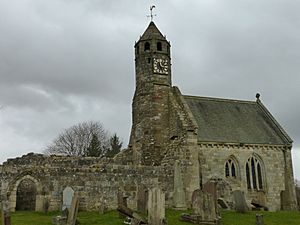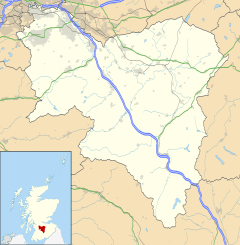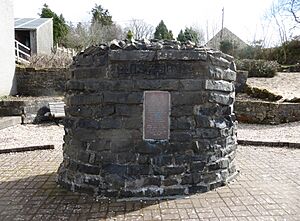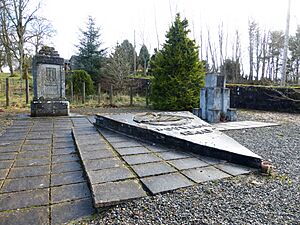Douglas, South Lanarkshire facts for kids
Quick facts for kids Douglas
|
|
|---|---|
 St Bride's Kirk, Douglas |
|
| Area | 0.58 km2 (0.22 sq mi) |
| Population | 1,460 (2020) |
| • Density | 2,517/km2 (6,520/sq mi) |
| OS grid reference | NS836305 |
| • Edinburgh | 38 mi (61 km) NE |
| • London | 319 mi (513 km) SE |
| Civil parish |
|
| Council area | |
| Lieutenancy area | |
| Country | Scotland |
| Sovereign state | United Kingdom |
| Post town | LANARK |
| Postcode district | ML11 |
| Dialling code | 01555 |
| Police | Strathclyde |
| Fire | Strathclyde |
| Ambulance | Scottish |
| EU Parliament | Scotland |
| UK Parliament |
|
| Scottish Parliament | |
Douglas (Scottish Gaelic: Dùbhghlas) is a small village in South Lanarkshire, Scotland. It sits on the south bank of the Douglas Water river. The village is also on the A70 road, which connects Ayr on Scotland's west coast to Edinburgh in the east. Douglas is about 12 miles southwest of Lanark.
The name Douglas comes from an old Scottish Gaelic phrase. Dub means "dark" and glais means "stream." This refers to the Douglas Water river. The famous Douglas family got their name from this area. Their ancestors settled here way back in the 1100s.
Contents
Douglas Village History
The village of Douglas grew because of the nearby Douglas Castle. This castle was the main home of the powerful Lords of Douglas. The first time Douglas Parish was mentioned was between 1203 and 1222. This was in a special document from Bricius de Douglas, who was a bishop.
Douglas Castle and the Wars of Independence
Douglas Castle was already well-known by 1288. At that time, William the Hardy, a Lord of Douglas, used it as a prison. The castle was taken over by English soldiers during the Scottish Wars of Independence. These wars were a long fight for Scotland's freedom.
However, a Scottish hero named Sir James Douglas freed the castle in 1307. He and his followers trapped the English soldiers inside the castle chapel. They set the chapel on fire, which also damaged parts of the castle. This brave act helped Scotland in its fight for independence.
Important Buildings in Douglas
Today, only a small part of Douglas Castle remains. It's a 17th-century corner tower, still called "Castle Dangerous." This name comes from a famous novel by Walter Scott.
Why Douglas Castle Was Demolished
In the 1930s, Charles Douglas-Home, the 13th Earl of Home, allowed coal mining near the castle. He did this to help people find jobs, as many were unemployed. The coal industry in Lanarkshire was struggling. Because of the mining, the castle was at risk of sinking into the ground. So, it had to be taken down in 1938 to keep people safe.
St. Bride's Church: A Historic Landmark
The oldest building still standing in Douglas is the ruin of St. Bride's Church. Like the castle, it was built in the 1300s. This church became the burial place for the Lords of Douglas.
The church has a clock that dates back to 1565. People say it's Scotland's oldest public clock that still works! It's believed that Mary, Queen of Scots gave the clock as a gift. She spent some time in the area. The clock was repaired in 2007 and 2008 and still tells time today.
The main church for the parish later moved to a new spot. The Douglas St Bride's Parish Church is there now. Its members currently worship at an even newer St Bride's Church, built a bit further away.
Douglas's Industrial Past and Heritage
The village of Douglas changed a lot during the Industrial Revolution. This was a time when new factories and machines were invented. Woollen mills and coal mining became very important here, just like in other Scottish villages.
You can learn more about the area's past at the heritage museum in Douglas. It shows how the village grew and changed over time.
Polish Army Camp and Memorial Garden
During World War II, a large camp for the Polish Army was set up near Douglas in 1940. Soldiers from different Polish cavalry units stayed here for a short time. They lived in temporary tents before moving north. Their job was to defend the east coast of Scotland from invasion.
Today, there is a special Memorial Garden in Douglas. It has three monuments that were created by the 10th Cavalry Brigade of the Polish Army. This garden remembers their time and service in Scotland.
Sports in Douglas
Glenbuck & Douglas Valley Football Academy is a local sports club. They play their games at Crabtree Park in Douglas.
The club was started in 2012. They are inspired by famous football manager Bill Shankly. They also look up to the original Glenbuck Cherrypickers team.
The academy has many different teams for various age groups:
- Boys (born in 2008)
- Mixed Junior teams (born in 2012, 2014, and 2016 Minikickers)
- Girls (training sessions)
- Mens (Walking Football)
Images for kids






